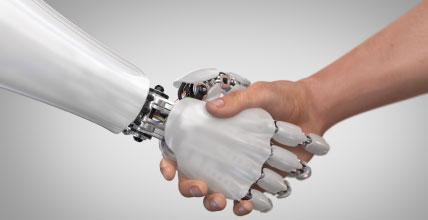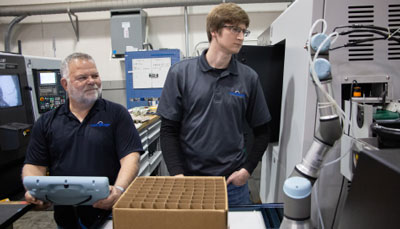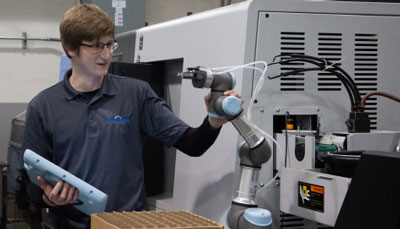- By Joe Campbell
- May 31, 2020
- Discrete Manufacturing
Summary
Fast Forward
- Using collaborative robots is decreasing scrap, increasing efficiency, and improving product quality.
- Collaborative robots opened new opportunities for employees to add value, improve safety, and gain job satisfaction.
- Improving production using collaborative robots was highly effective with ROI under one year.
Creates new opportunities for employees to add value, improve safety, and improve job satisfaction
By Joe Campbell 
Jim Lee, Tool Gauge general manager, faces the stark realities of doing business in a global market. Even though the company is close to many of its customers in the Pacific Northwest, their customers can do business anywhere in the world, including in much lower-cost labor markets. It became clear to the company that the way to compete in a global market is more automation to improve efficiency and quality and to add more value. The company’s fixed-price contracts can extend for five to seven years, without the ability to renegotiate even if labor costs increase. Tool Gauge needed to build in efficiencies and found cobots were the perfect solution.
In the past, Tool Gauge has been a bit trepidatious about using automation, because there is a huge capital investment for robots, so the challenge was to find solutions that required lower capital investment and improved return on investment (ROI). Additionally, the company was concerned about the cost and complexity of implementing traditional robots that require walling off portions of their manufacturing to put in automation cells with elaborate safety interlock systems.
The best use case
After learning about and analyzing new options, Tool Gauge installed two collaborative robots—or “cobots”—from Universal Robots to address repetitive, high-labor applications in both its metal and plastic parts departments. On the metal side, an easily damaged copper machined part was being produced and being fully attended by a highly skilled journeyman CNC machinist simply to pull parts off the CNC chute, and clean, rinse, dry, and box them. In the new configuration, the parts pass a proximity sensor that sends a signal to a cobot to pick them up. The cobot places parts in a rinse bath, then holds them up in front of a dryer and drops them into individual cardboard cells when dry. This frees up a highly skilled journeyman CNC machinist to do higher value-added work.
Tool Gauge used the palletizing wizard built into the system to configure the cobot to drop each part into an open cell in the box in a grid pattern without complex programming. Additionally, when it put the robot in place, there was a labor savings of $9,000 on the very first order.

Cobot doubles production while reducing labor by 75 percent
In the injection molding department, a cobot is used for an intricate plastic extrusion assembly, picking up end caps for a plastic panel, and moving them through a glue dispenser. After correctly dispensing the glue in the end cap, the robot places the part in an actuator on a table where the part is clamped. An operator then takes over, inspects the glue, and removes the part. This task previously required four operators to produce about 200 units per day. Now, the automated application requires one operator working with the cobot to produce four hundred units per day.
General manager Lee adds, “What I thought would be one of the most difficult assembly operations—using a robot to apply glue on a very complex surface—works very, very well.” Beyond the labor savings, Lee also emphasizes the quality and consistency of the robotic bond, and the fact that it gives operators time to inspect the bond rather than just producing the part as quickly as possible.
Not only was it difficult for a human operator to dispense glue exactly the same way every time, potential injury was also a concern. This is because the area where the glue needs to be applied is incredibly narrow, so over time, operators were experiencing fatigue in their hands. The company has gained additional savings through a decrease in repetitive motion injuries. The robots have also enabled Tool Gauge to appeal to younger workers, providing a hiring advantage for recent graduates who want to work with exciting, interesting technologies.
Easy programming key for workers without robot experience
Tool Gauge manufacturing engineer Steve Ouzts had minimal robotic experience—just some time in college using a traditional, nonintuitive SCARA robot. The easy programming of the cobots experience was a huge benefit. “When switching to Universal Robots, the intuitive nature of the graphic user interface is what really drew me in,” he says. “I really appreciate how all the terms in the software are in layman’s terms. I can understand them a lot easier and know exactly how the code runs from start to finish, and I get very good positive feedback graphically of what my actions will cause the robot to do.”
Another benefit of the cobots is how easy it is to connect digital and analog input signals to a control box. Ouzts found that using the proximity sensor was as easy as plugging the wires into one of the 12-volt digital inputs, selecting it from the I/O screen on the cobot teach pendant, and waiting for a signal from the sensor to tell the cobot when it is time to pick up a part.

Employees welcome cobot colleagues
One of the first reasons Tool Gauge looked at automation was to address serious labor shortages. The company was looking at the need to hire as many as 100 new employees, who simply were not available in the tight Pacific Northwest labor market. With cobots, the company cut that number in half, while being able to hire workers for jobs they desire.
ROI much faster than anticipated
In the aerospace industry, where product designs can remain unchanged for 20 or 30 years, expectations for a return on capital investment is longer than many other industries. Lee initially thought that a three- or a four-year return on the robot investment would be good. He was pleasantly surprised by the 50 percent ROI on the cobot investment within the first quarter of production on the first application, and with projected payback for both cobots of under a year. “We’re very thrilled with that,” he states.
The cobots’ ability to be easily moved and reprogrammed for additional processes, with easy changes of end-of-arm tooling, lets Tool Gauge look at a wide range of tasks where cobot advantages can improve processes and output. For instance, traditional robots on injection molding machines could be replaced with cobots, and cobots could tend presses and other machining tasks, as well as final assembly. As easy as it is to move the cobots to new applications, the company is also looking forward to bringing in more robots to take on additional high-volume jobs, including one for riveting and assembly.

Reader Feedback
We want to hear from you! Please send us your comments and questions about this topic to InTechmagazine@isa.org.


